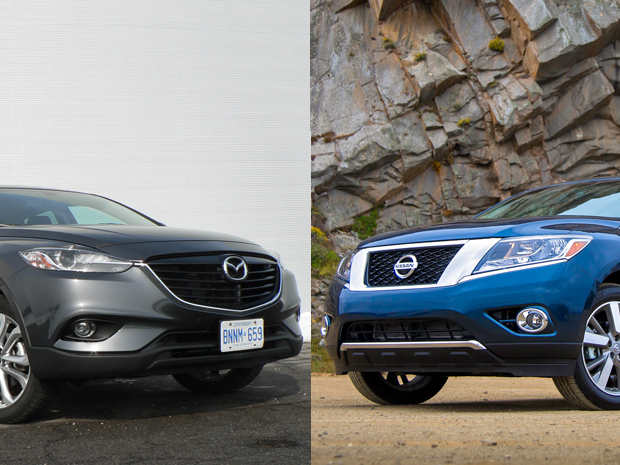Comparo: 2013 Mazda CX-9 versus Nissan Pathfinder
Story by John LeBlanc
Although they often get lumped together, sport utility vehicles (SUVs) and crossover utility vehicles (crossovers) are very different beasts. A good example of the differences can be seen with the all-new 2013 Nissan Pathfinder.
The new, three-row Nissan crossover uses a car-based (or unibody) frame instead its predecessor’s heavier truck-based (or body-on-frame) design. Not only lighter (and therefore better on gas), the 2013 Pathfinder is also more space-efficient than the outgoing version. The Pathfinder as a crossover also drives more like a car than the Pathfinder as an SUV. But to find out how much better, I put it up against one of the better-driving crossovers out there, the 2013 Mazda CX-9.

FIRST PLACE: 2013 Mazda CX-9 GT
Just as the new-age Pathfinder uses an extended version of the five-passenger Nissan Murano crossover’s platform, the seven-passenger CX-9 is essentially a stretched Ford Edge/Lincoln MKX. On sale since 2007, for 2013, Mazda’s largest vehicle gets its biggest makeover yet, with new styling on the outside and a thoroughly updated interior. And it still remains an excellent crossover for drivers.
Most buyers looking for a seven-seat utility vehicle aren’t staying awake at night dreaming about clipping apexes or taking highway on-ramps at ten-tenths. But if you’re one of those rare types of buyers, the CX-9 is a better choice than the less athletic Pathfinder.
Whereas the Nissan will roll in sharp corners, the CX-9 stays relatively flat. The Mazda’s steering system is accurate, definitive and linear, and gives real-time feedback as to what’s going on at road level. And even with its firm ride, the CX-9 feels rattle-free and tight from the driver’s seat. With 273 horsepower and 270 pound-feet of torque, the Mazda’s 3.7-litre six-cylinder offers more oomph than the Nissan’s 260 hp and 240 lb-ft 3.5L six. We also preferred the more natural shift behaviour of the Mazda’s conventional six-speed automatic to the Nissan’s whiny continuously variable autobox.

The Mazda’s cabin is also a step up over the Nissan in quality. Fit and finish is excellent and the front seats provide more lateral support. And while the CX-9 is narrower than the Pathfinder, the Mazda offers more cargo room with either the third-row seats up or down.
Overall, the Mazda feels like a more premium crossover than the Nissan. And that shows up in its pricing.
Front-wheel-drive CX-9 GS models start at $33,995 — about $4,000 more than a base Pathfinder. I tested a topline, all-wheel-drive CX-9 GT version that added larger wheels, Xenon HID headlights, power moonroof, leather seating and a blind-spot monitoring system — among other details — over the GS trim. The only option on my tester was a $2,500 Navigation Package. With an $1,895 freight and PDI charge, the total came to $49,145, a substantial chunk of change over a similarly equipped $43,818 Pathfinder Platinum.

SECOND PLACE: 2013 Nissan Pathfinder Platinum
While both of these seven-passenger crossovers take 7.8 seconds to go from zero to 100 km/h, the Nissan feels slower. It’s certainly slower to react when you need to make those vital 80-to-120-km/h passing manouvres. I know the Pathfinder’s steering wheel is somehow connected to its front tires, but the lack of feedback argues otherwise. And as if to prevent its owners from ever getting a speeding ticket, the Pathfinder wallows and heaves on its soft suspension setup, discouraging any kind of enthusiastic driving.
Now that we’ve established the CX-9 GT offers a near-luxury driving experience, the topline, all-wheel-drive Pathfinder Platinum stands out more for its practical attributes. The Nissan is less expensive to get into, offers more passenger room, better fuel economy, more towing capacity and some high-tech convenience tricks.

Nissan is making a big deal about the Pathfinder crossover shedding 200 kilograms of curb weight over the Pathfinder SUV. At 2,044 kg, however, the new Nissan only weighs 18 kg less than its Mazda rival. That said, the combination of its less powerful V6 and fuel economy-oriented CVT means the Pathfinder’s fuel economy estimates of 10.8 L/100 km in the city and 7.9 on the highway handily beat the Mazda’s respective 12.8 and 9.7 ratings. And if you need to tow, the Pathfinder has a 2,260 kg towing capacity, compared to the CX-9’s 1,588.
With a slightly longer wheelbase and much wider cabin, the Nissan also offers more room for its seven occupants than the Mazda. Third-row seating access is much easier in the Pathfinder, too, with a second row that tilts and slides out of the way. And because the Pathfinder was developed with its upscale Infiniti JX counterpart, high-tech goodies like the 360-degree “Around View Monitor” system (its four cameras stitch together an “overhead” view of the Pathfinder’s surroundings when backing up and parking), and heated and cooled front seats are standard kit on the upscale Platinum model.
As an alternative to a minivan, the new Pathfinder crossover is a must-see, but if you’re considering a luxury crossover (like an Acura MDX, Audi Q7 or BMW X5), the CX-9 would be my choice.






![[del.icio.us]](https://www.straight-six.com/wp-content/plugins/bookmarkify/delicious.png)
![[Digg]](https://www.straight-six.com/wp-content/plugins/bookmarkify/digg.png)
![[Facebook]](https://www.straight-six.com/wp-content/plugins/bookmarkify/facebook.png)
![[Google]](https://www.straight-six.com/wp-content/plugins/bookmarkify/google.png)
![[Reddit]](https://www.straight-six.com/wp-content/plugins/bookmarkify/reddit.png)
![[StumbleUpon]](https://www.straight-six.com/wp-content/plugins/bookmarkify/stumbleupon.png)
![[Twitter]](https://www.straight-six.com/wp-content/plugins/bookmarkify/twitter.png)
![[Email]](https://www.straight-six.com/wp-content/plugins/bookmarkify/email.png)